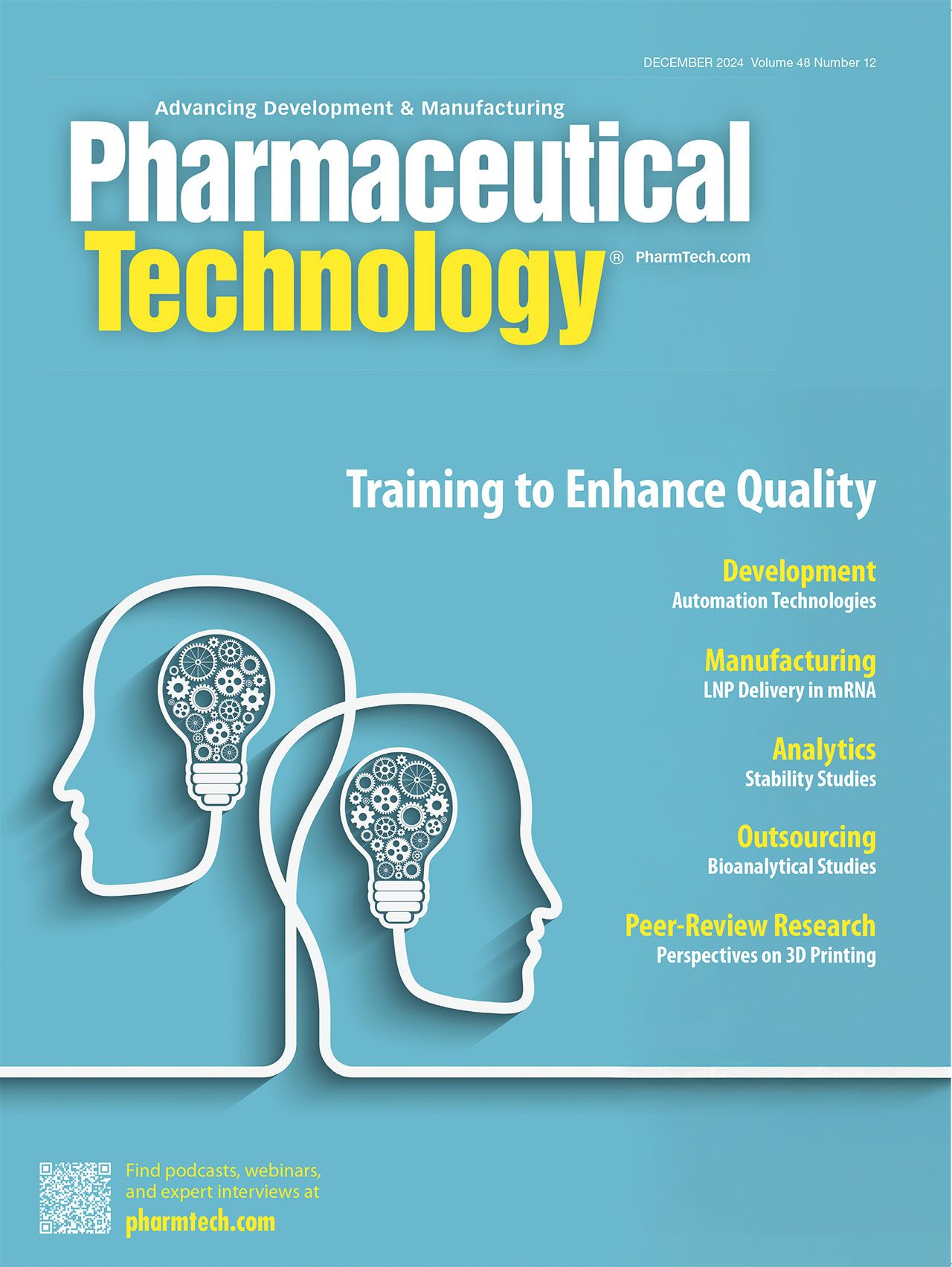Leveraging Advancements in Bioanalytical Testing
As the field of bioanalytical testing evolves, it is important for drug developers to stay at the forefront of the advancements to ensure they remain competitive.
Close-up of a microscope lens examining microarray slides, a crucial tool in genomic research and medical diagnostics | Image Credit: © Varunee - Stock.Adobe.com

It is well-known that developing a drug from the discovery through to commercialization is a costly endeavor, with market analysis showing that the average R&D cost to develop an asset for 2022–2023 was $2.3 billion (1). However, many drugs do not make it through to commercialization, in fact it has been reported that clinical attrition rates for drugs that have reached Phase I trials is as high as 90% of drug candidates (2).
As a result of the high costs and level of risk inherent with drug development, it is imperative that companies efficiently determine the safety and efficacy of their candidates, to minimize any potential failure. “Bioanalytical testing is essential in drug development because it ensures the safety, efficacy, and quality of pharmaceutical compounds through quantitative analysis of drugs and their metabolites in various biological matrices such as plasma, urine, blood tissue, [and so on],” asserts Sujata (Suzzy) Bhavekar, study director at SGS North America. “Early identification of side effects through rigorous testing can reduce development costs by up to 20% (3). Drugs with robust bioanalytical data are 50% more likely to gain regulatory approval (4).”
Importance of bioanalysis
“Bioanalytical testing covers a range of techniques and technologies used to quantify drugs and their metabolites, or biomarkers, in biological media,” adds Iain Love, director, Chromatographic Bioanalysis & Discovery Sciences, Department of Chromatographic Bioanalysis, Charles River. “The concentration data generated through bioanalytical testing are important as they inform researchers on how long a drug stays in the body and the beneficial effects or otherwise while it’s in there. Knowing the concentration of drug candidates and understanding the levels at which the drug has positive or negative effects on the body is critical to drug development.”
Vital data on drug absorption, distribution, metabolism, and excretion can be gained through bioanalytical studies, which helps developers to determine dosing regimens, agrees Bhavekar. “Poor pharmacokinetics contribute to 30% of drug failures, highlighting the importance of accurate testing (5),” she says.
Additionally, bioanalytical studies help with biomarker discovery, which improves the success rate of targeted therapies by 25% and supports personalized medicines (6), Bhavekar continues. Furthermore, suitable bioanalytical testing helps ensure compliance with regulatory standards, including good laboratory practice (GLP) and good clinical practice (GCP). “Approximately 85% of drug applications meet approval criteria with solid bioanalytical data (7),” Bhavekar says.
Regulatory considerations
“Regulatory considerations are extremely vital in bioanalytical studies to ensure compliance with international standards and facilitate successful drug approval,” continues Bhavekar. “Adhering to GLPs and GCPs is essential to ensure data accuracy, reliability, and reproducibility.”
“Bioanalytical testing is carried out according to strict inter(national) guidelines and quality management systems,” agrees Love. “Monitoring authorities translate globally recognized quality management systems into national regulations.”
At the national level, there are guidelines such as FDA’s guidance documents on bioanalytical method validation and immunogenicity (7,8) and the European Medicines Agency’s guidance on bioanalytical method validation (9), Bhakevar adds. “Compliance with 21 CFR [Code of Federal Regulations] Part 11 (10) is crucial for maintaining the credibility of electronic records and ensuring data integrity,” she says.
“In addition to these national regulations, bioanalytical studies are also carried out following the International Council for Harmonisation (ICH) M10 guideline,” confirms Love. In fact, EMA’s guidance on bioanalytical testing has been superseded by the ICH guidance (11), since its publication in 2022.
“The ICH M10 guideline provides a harmonized approach across various regions including the US [United States], EU [European Union], Japan, and other member countries [and] provides a robust framework for validating methods, focusing on precision, accuracy, selectivity, sensitivity, and reproducibility, thus enhancing global consistency in bioanalytical testing,” Bhakevar specifies. “These regulatory frameworks, including ICH M10 and FDA guidelines, form the backbone of robust bioanalytical testing, driving drug development toward clinical and commercial success.”
Role of a partner
“Outsourcing partners are an increasingly important piece of the drug development puzzle,” notes Love. “Partnership with a bioanalytical provider can bring about several tangible advantages that can help get drugs to the patients who need them in the shortest time possible. This could be from simple access to appropriate analytical platforms to receiving advice on planning the development program.”
In terms of regulatory compliance, the right partnership with a contract research organization that complies with global regulatory standards can ensure that the bioanalytical data generated meets the relevant requirements, Bhakavar explains. “Comprehensive services [provided by a partner company], including method development, validation, and routine analysis, allow sponsor companies to focus on core R&D activities while relying on their outsourcing partner for specialized testing,” she says.
“Outsourcing partners are also likely to be able to apply experience gathered from across a broad portfolio of modalities and development scenarios that can inform program decision-making,” confirms Love. “More than ever, bioanalytical science is involved in shaping programs, so careful selection of an expert outsourcing partner is an activity that can bring about the significant benefits involved with an accelerated drug development program.”
There are also benefits in terms of the flexibility and scalability of operations that a partner company can provide for a sponsor’s needs, Bhavekar remarks. “Outsourcing provides flexibility in scaling bioanalytical operations according to project needs, from preclinical to late-stage clinical trials. This scalability helps manage resources efficiently and reduces the burden on in-house teams,” she says. “[Additionally], with large-scale facilities and automated processes, outsourcing partners can handle high volumes of samples, ensuring rapid data delivery and accelerating the drug development timeline.”
“[Furthermore], outsourcing partners invest in cutting-edge technologies and platforms, such as mass spectrometry and immunoassays, to deliver precise and reliable data, which may not be feasible for smaller companies to implement internally,” specifies Bhavekar. “Overall, outsourcing bioanalytical testing to a reputable partner can enhance the efficiency and quality of the drug development process, enabling sponsor companies to achieve their project goals more effectively.”
Advancements in bioanalytical testing
“There has never been a more vibrant time to be involved in bioanalytical testing. It’s sometimes a challenge to keep up with the innovation both from within the drug development industry and from supporting partners,” notes Love. “There have been, and continue to be, some hugely innovative therapies discovered and developed by the pharma and biotech sectors. At the same time, instrument and software manufacturers continue to push boundaries with what can be done to generate extremely powerful data in support of drug development.”
An area of great interest for Love is that of patient centric sampling (PSC), which is “the description given to a number of techniques and approaches that affords patients choice: choice on how a biosample is taken but also the choice of whether to provide biosamples in a clinical setting or remote from a clinical setting,” he says. “This enablement of decentralized trials is potentially the biggest and most impactful paradigm change in the clinical space for a long time.”
For Bhavekar, the many advancements that have been seen in the field of bioanalytical testing have helped to greatly improve the analysis of both small and large molecules in drug development. For example, she highlights the hybrid approach of combining ligand-binding assays with liquid chromatography coupled with tandem mass spectroscopy as a way of improving sensitivity and specificity of bioanalytical studies for both small and large molecules.
Platform approaches represent another advancement in the field, Bhavekar continues. “Enzyme-linked immunosorbent assay, plasmon resonance immunoassay, hybridization assay, immuno-PCR [polymerase chain reaction] assay, and the Meso Scale Discovery platform are widely utilized methodologies,” she says. “These platforms are highly specific and sufficiently sensitive, enabling the generation of controlled and customized data that meets regulatory compliance standards.”
Other advancements include chromatographic-based techniques for greater analysis of samples, circular dichroism and differential scanning colorimetry for the assessment of stability and structural changes in large molecules, electrophoresis to help with the separation of proteins and large-molecule characterization, and multiplex immunoassays to gain insights into complex biological samples, Bhavekar notes.
“The bioanalytical field is continuously evolving, with ongoing research into novel biomarkers, advanced detection methods, and personalized medicine approaches. Staying at the forefront of these innovations is crucial for maintaining a competitive edge in the industry,” concludes Bhavekar. “By focusing on [more than just the core] aspects, sponsor companies can leverage bioanalytical testing not just as a regulatory requirement but as a strategic tool for advancing drug development and achieving market success.”
References
1. May, E.; Taylor, K.; Gupta, L.; Miranda, W. Unleash AI’s Potential: Measuring the Return from Pharmaceutical Innovation—14th Edition. Annual Report, Deloitte, April 2024.
2. Sun, D.; Gao, W.; Hu, H.; Zhou, S. Why 90% of Clinical Drug Development Fails and How to Improve it? Acta Pharm. Sin B. 2022 12 (7) 3049–3062.
3. Smith, J. and Doe, A. The Impact of Early-Phase Clinical Testing on Drug Development Costs. Pharmaceutical Development and Technology, 2019 24(3), 225-233.
4. FDA. Drug Approval Statistics. 2022 Retrieved from https://www.fda.gov/drugs/drug-approvals-and-databases.
5. Anderson, J. and Smith, R. Impact of Pharmacokinetics on Drug Development. Journal of Pharmacokinetics and Pharmacodynamics 2021, 48(2), 123-130.
6. Johnson, R. and Lee, K. Biomarker Discovery and Its Role in Targeted Therapy. Nature Reviews Drug Discovery, 2020 19(4), 285-298.
7. FDA. Bioanalytical Method Validation. Guidance for Industry, May 2018.
8. FDA. Immunogenicity Testing of Therapeutic Protein Products — Developing and Validating Assays for Anti-Drug Antibody Detection. Guidance for Industry, January 2019.
9. EMA. EMEA/CHMP/EWP/192217/2009 Rev. 1 Corr. 2** Guideline on Bioanalytical Method Validation. Guidance Document, July 2011.
10. US CFR Title 21, 11 (Government Printing Office, Washington, DC) 241–246.
11. ICH. M10 Bioanalytical Method Validation and Study Sample Analysis. Final Version, May 24, 2022.
About the author
Felicity Thomas is the Associate Editorial Director for Pharmaceutical Technology Group.
Article details
Pharmaceutical Technology®
Vol. 48, No. 12
December 2024
Pages: 30–32
Citation
When referring to this article, please cite it as Thomas, F.
Leveraging Advancements in Bioanalytical Testing. Pharmaceutical Technology, 2024, 48 (12) 30–32.

WMFTS’ BioPure to Showcase Single-Use Bioclamp with Refined Manufacturing at INTERPHEX 2025
April 1st 2025With advanced manufacturing, BioPure’s BioClamp connector is manufactured to be 13% lighter than the previous model, resulting in a 26% reduction in carbon dioxide emissions across the full lifecycle of the product.